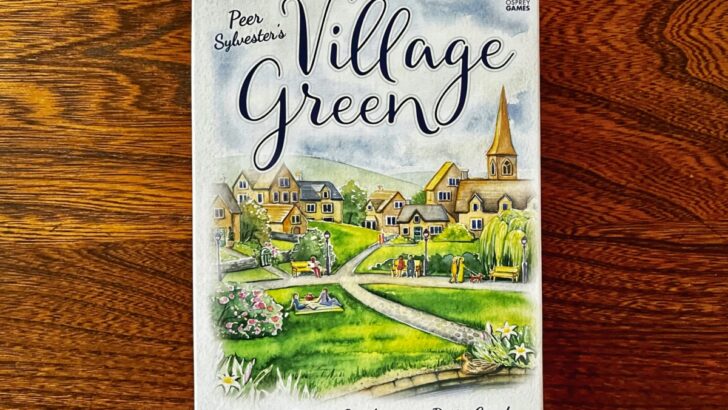It’s that time of year again: the Village Green of the Year competition. Do you have what it takes to plant your trees and flowers nicely in a row to win prestigious Awards?
Read our Village Green review to learn more about this beautifully illustrated card game.
Contents
Village Green Overview
Village Green is a card game for 1 to 5 players who compete to cultivate the most beautiful green space for their village and earn prestige in the form of Awards.
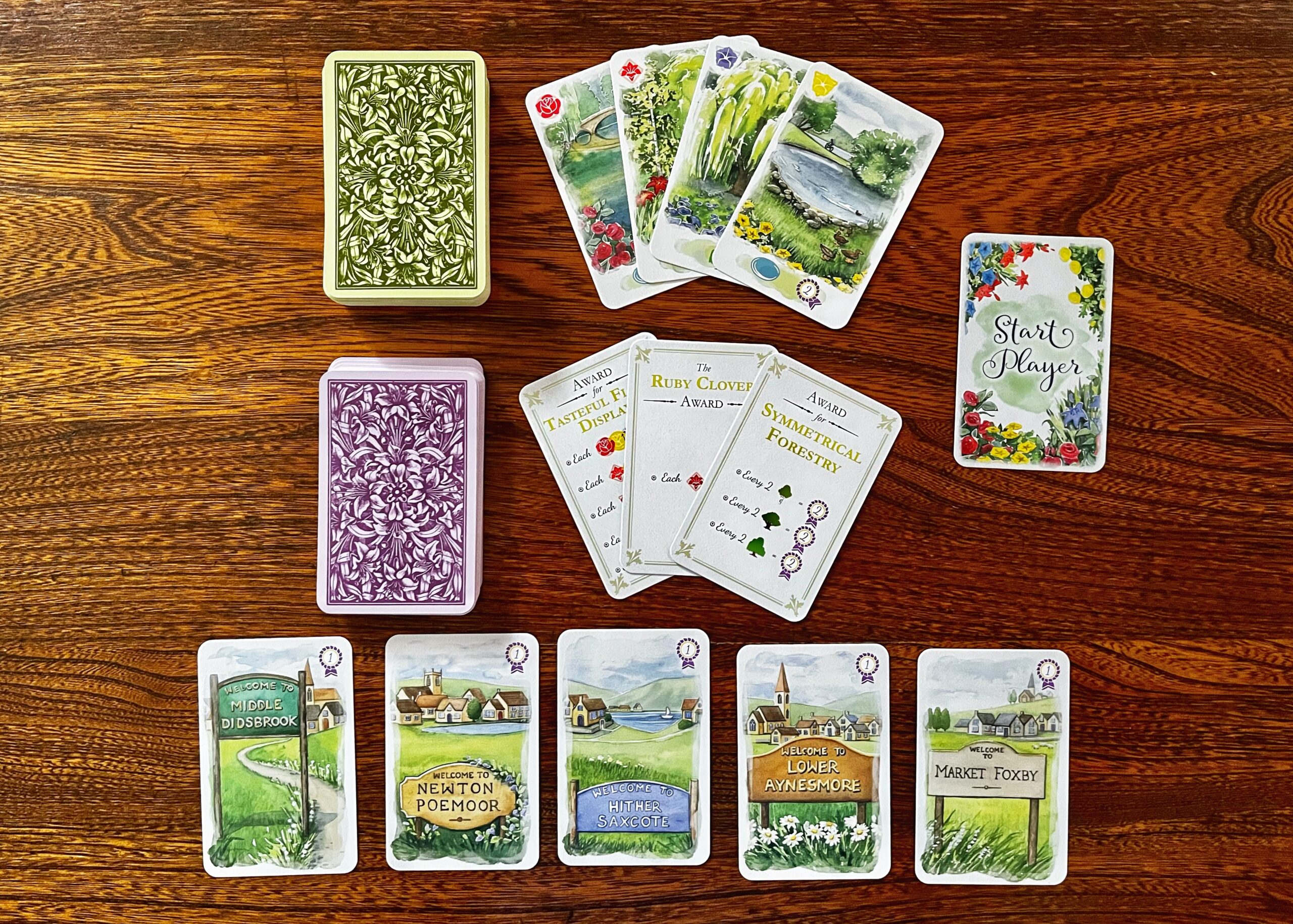
The components in Village Green.
During the game, players will add up to 9 visible Green cards depicting various features to their village.
They’ll also have an opportunity to gain different Award cards that only they will use to score points.
Types of Cards
Village Green includes 96 cards:
- 60 Green cards,
- 30 Award cards,
- 5 Village cards (1 for each player), and
- 1 Start Player card.
Green Cards
Each Green card has a flower — rose, petunia, or lily in either red, blue, or yellow — in its top left corner.
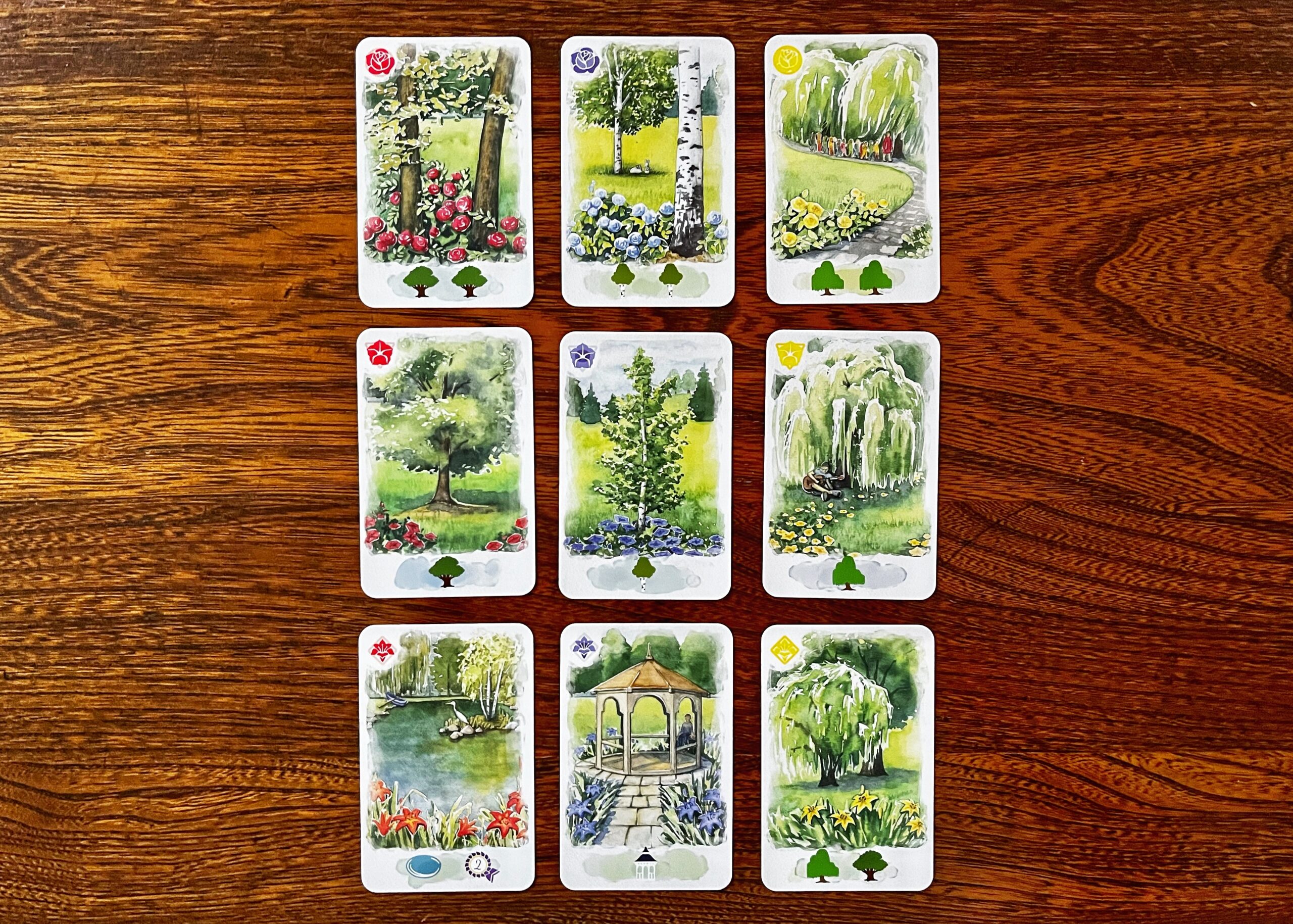
Cards depicting roses, petunias, and lilies in the 3 colors (red, blue, and yellow).
The bottom of the Green cards also shows various features — trees, structures, ponds, and lawns — that have different effects when played.
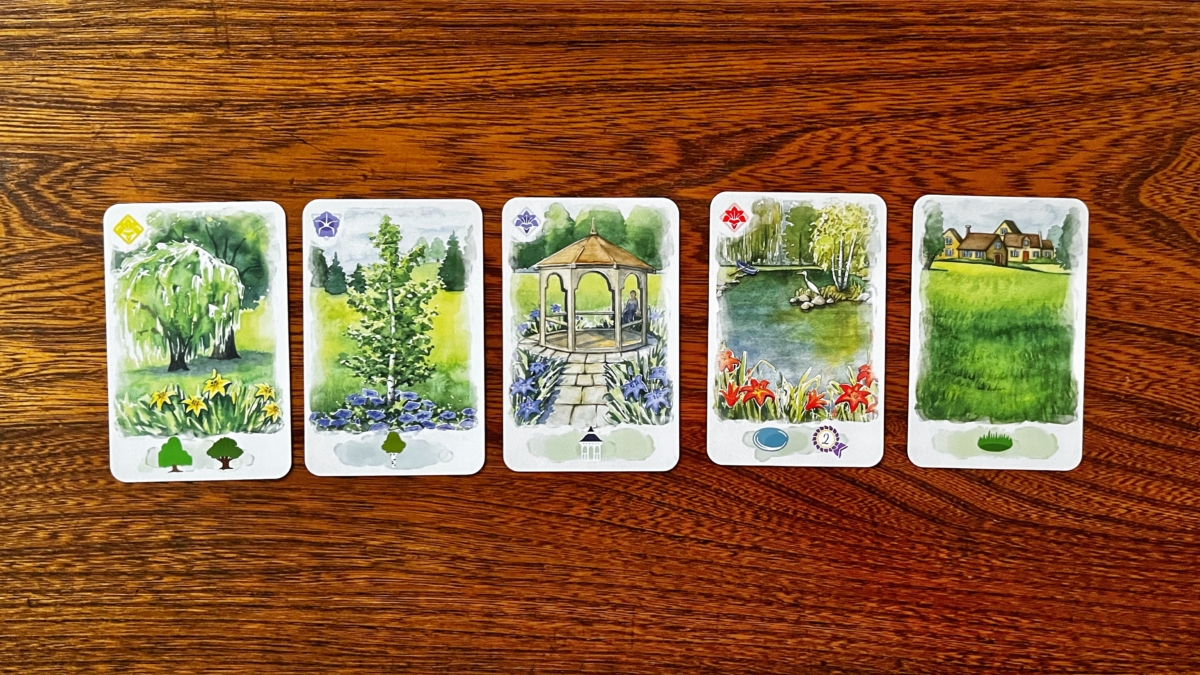
Here are cards, from left to right, showing the trees, structure, pond, and lawn features.
Award Cards
Award cards are the main way in which you’ll score points in Village Green; each has a unique name and scoring condition.
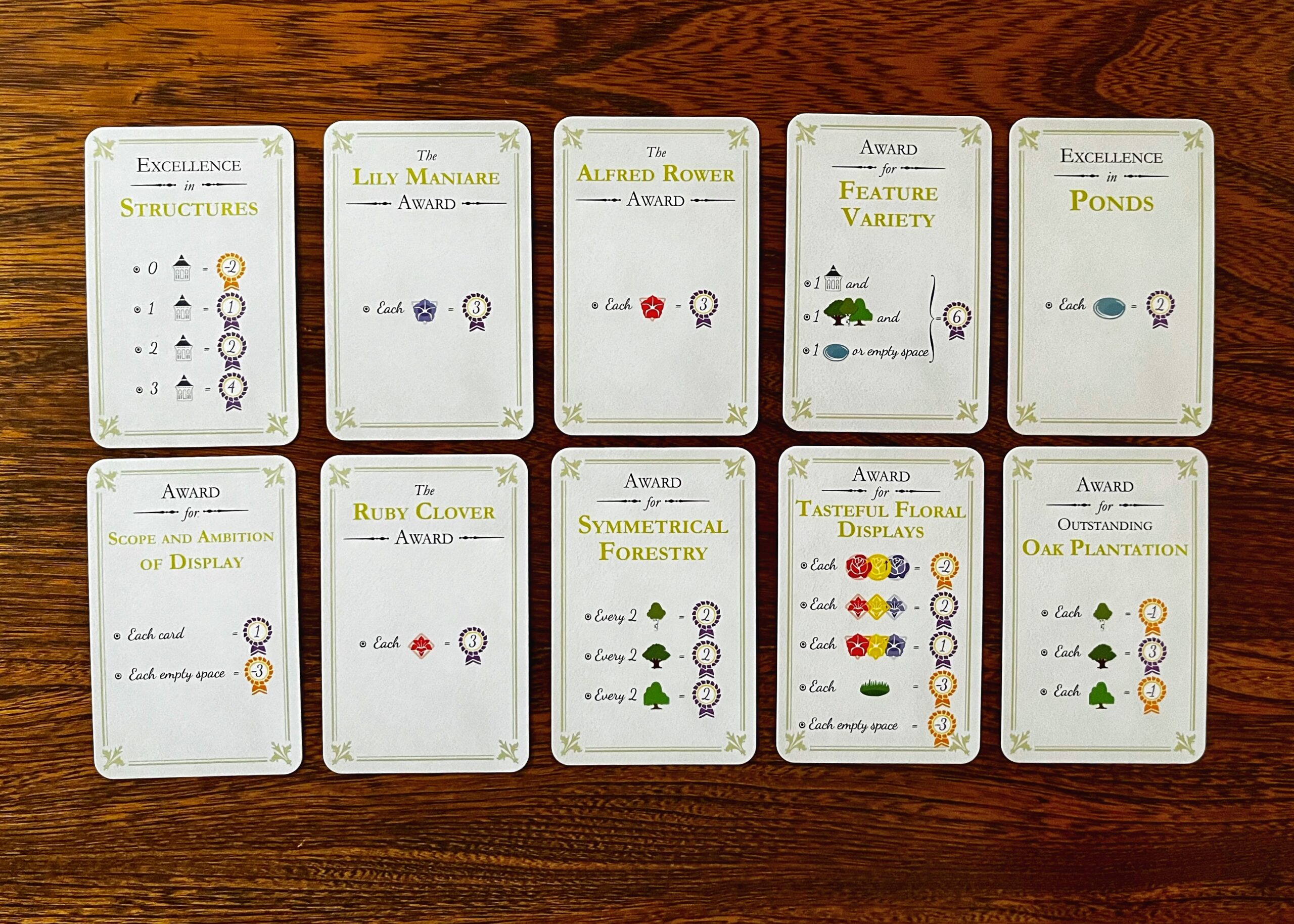
Some Award card examples.
During the game, you’ll have the opportunity to customize your village using personal Award cards that score flowers, colors, and features on the Green cards that you added during the game.
Village Cards
Every player starts the game with 1 Village card that begins in their village; this card gives you a once-per-game ability that you can use before taking an action on your turn.
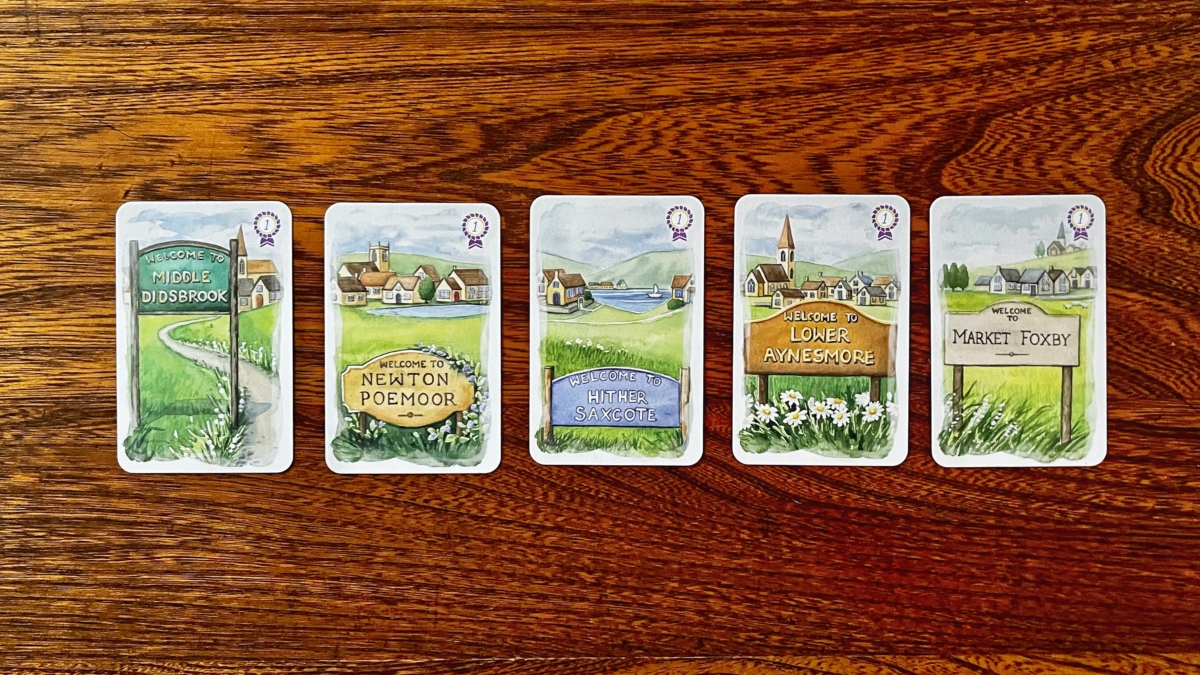
The 5 Village cards.
Your Village
In a game of Village Green, you’re trying to build up your village by playing Green and Award cards to it.
Each player’s village area consists of a 4×4 grid with your Village card in the top left corner.
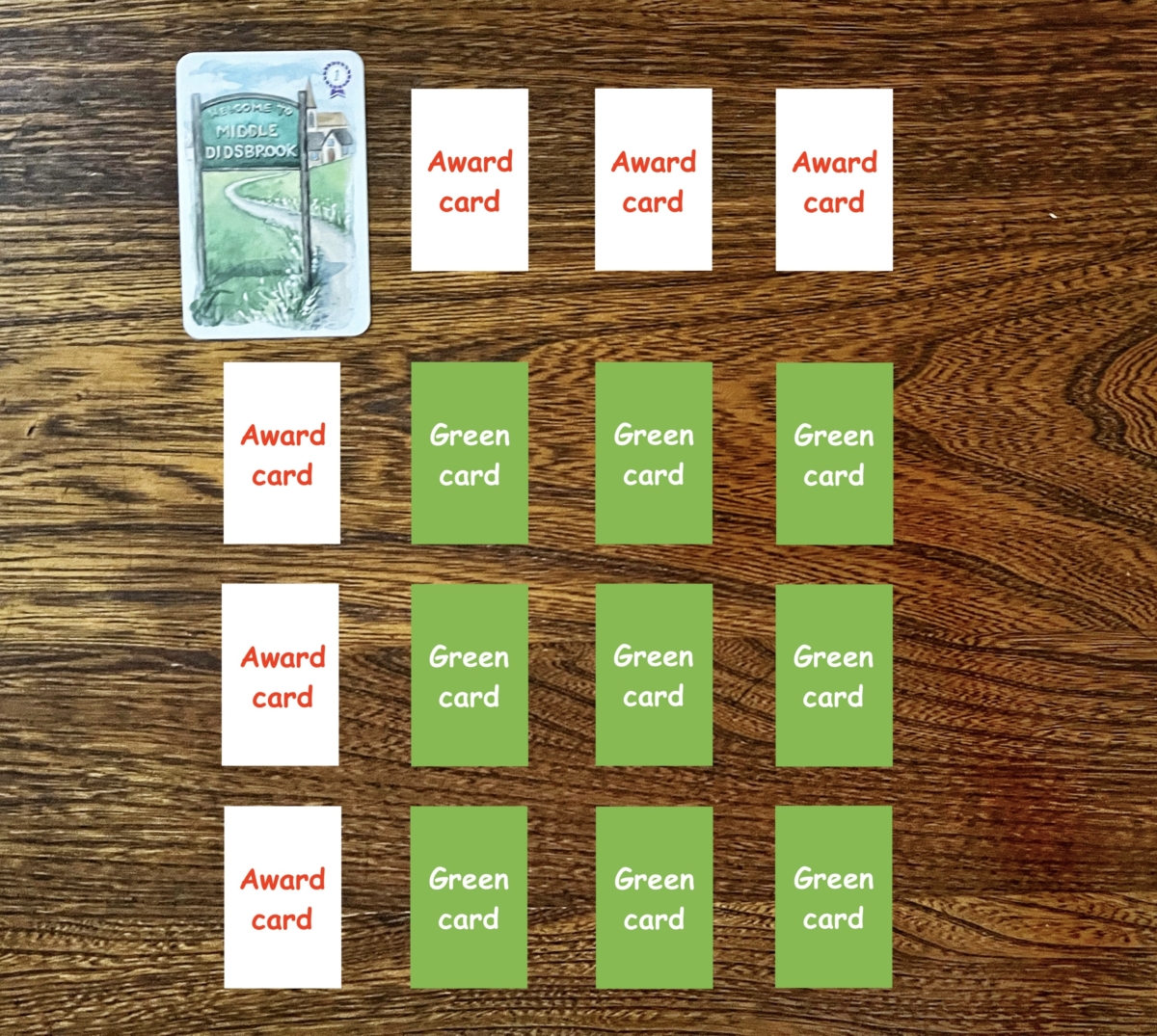
Before any Green or Award cards are added, a player’s village looks like this (with their Village card). This 4×4 grid has room for a maximum of 6 visible Award cards that border 9 Green cards.
How To Play Village Green
Setup
In setup, each player gets 1 Village card, 3 random Award cards, and a hand of 3 Green cards that they keep secret.
The Village and Award cards, however, are placed immediately into their village, forming its top row.
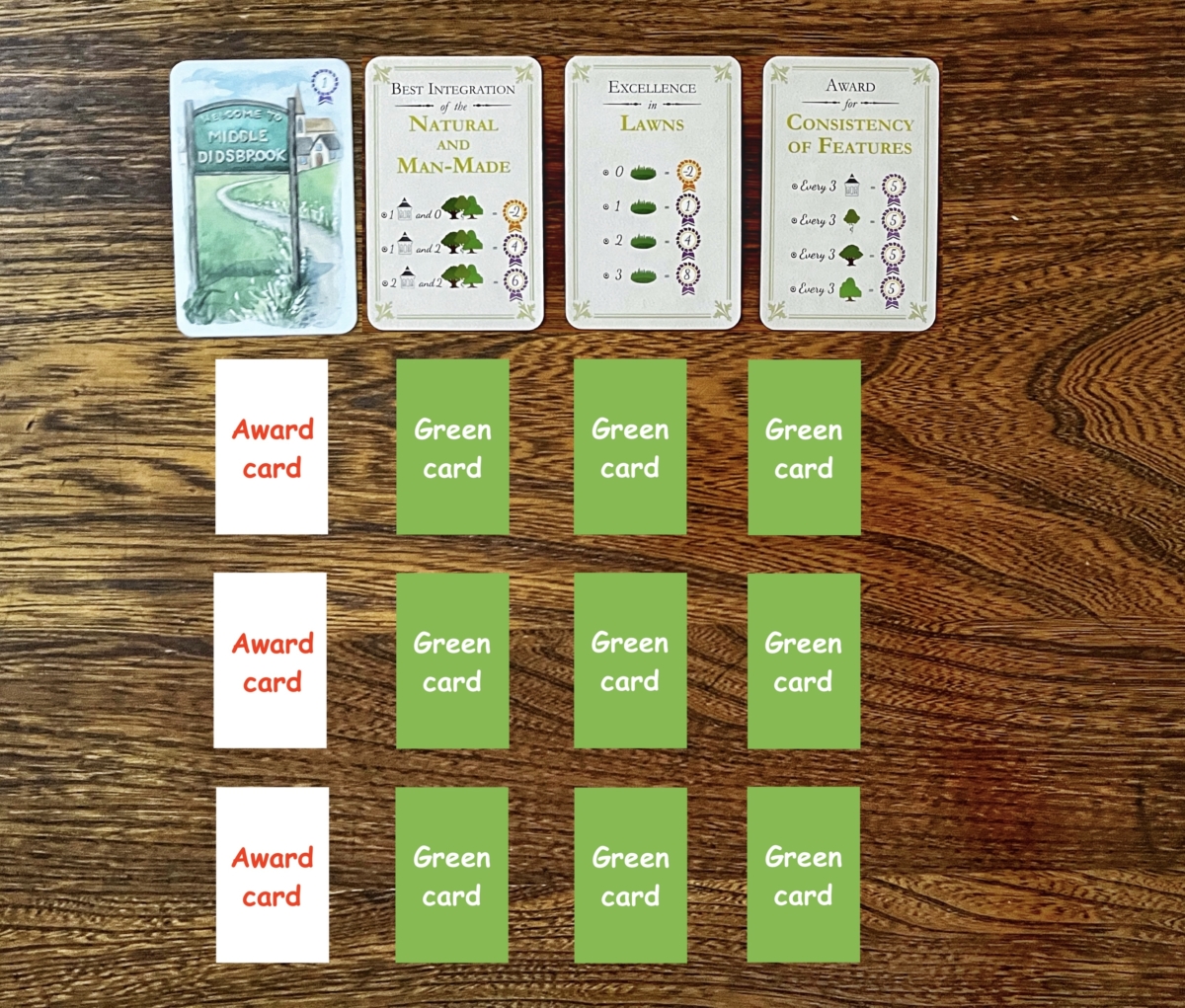
This is what a player’s village would look like at the beginning of the game (minus the drawn rectangles, of course).
The remaining Green and Award cards form 2 facedown draw piles. Then, 3 cards from each deck are placed faceup, creating a display.
Player Turn
Beginning with the start player and proceeding in clockwise order, each player performs 1 action on their turn until the endgame is triggered.
On your turn, you may do 1 of the following actions:
- Draw and play a Green card or
- Draw and play an Award card.
Regardless of its type, when drawing a card, you may choose 1 from the faceup display or off the top of its facedown draw pile.
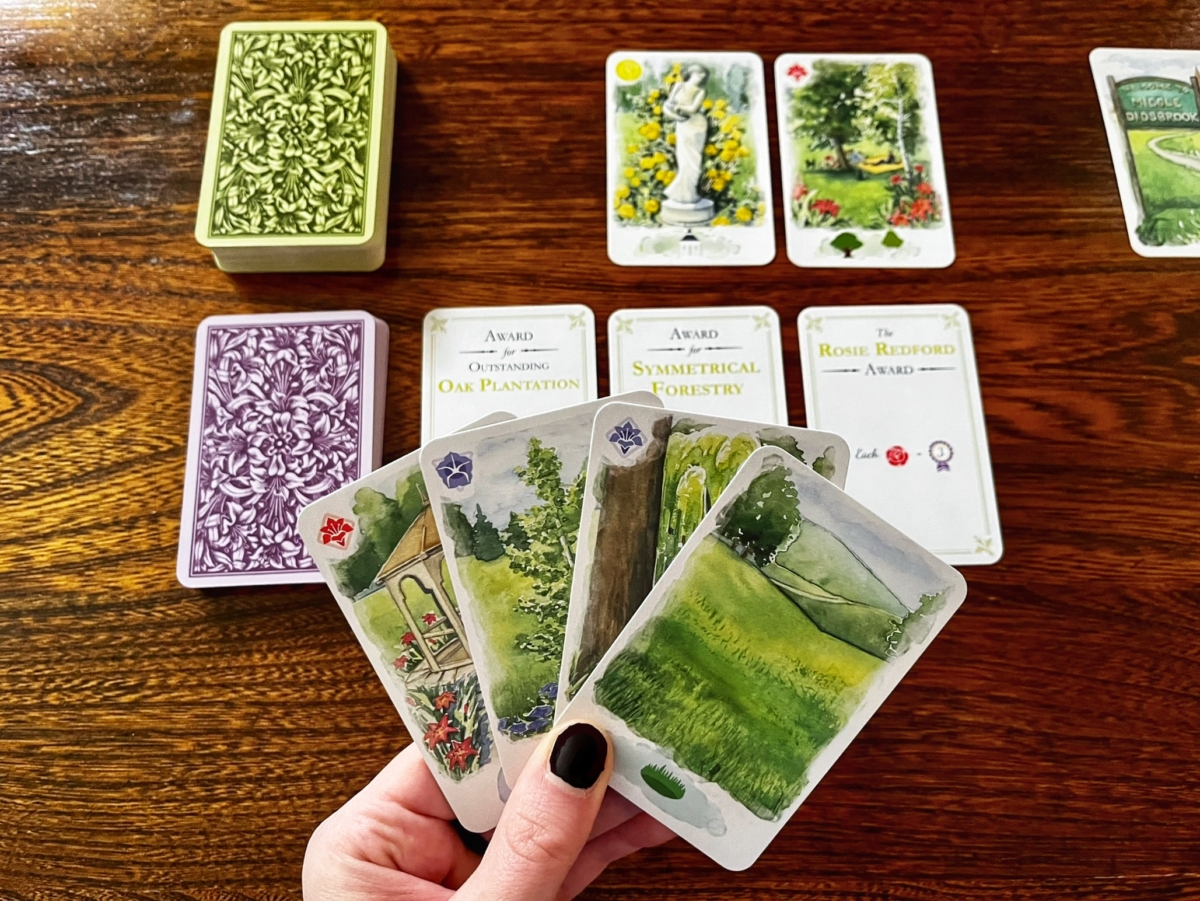
On this player’s turn, they choose to draw 1 Green card, then they will play any 1 Green card from their hand to their village.
When performing the Green card action, you first add the new Green card to your hand, and then you may play a single Green card to your village.
An Award card, however, is drawn then it must be played immediately to your village.
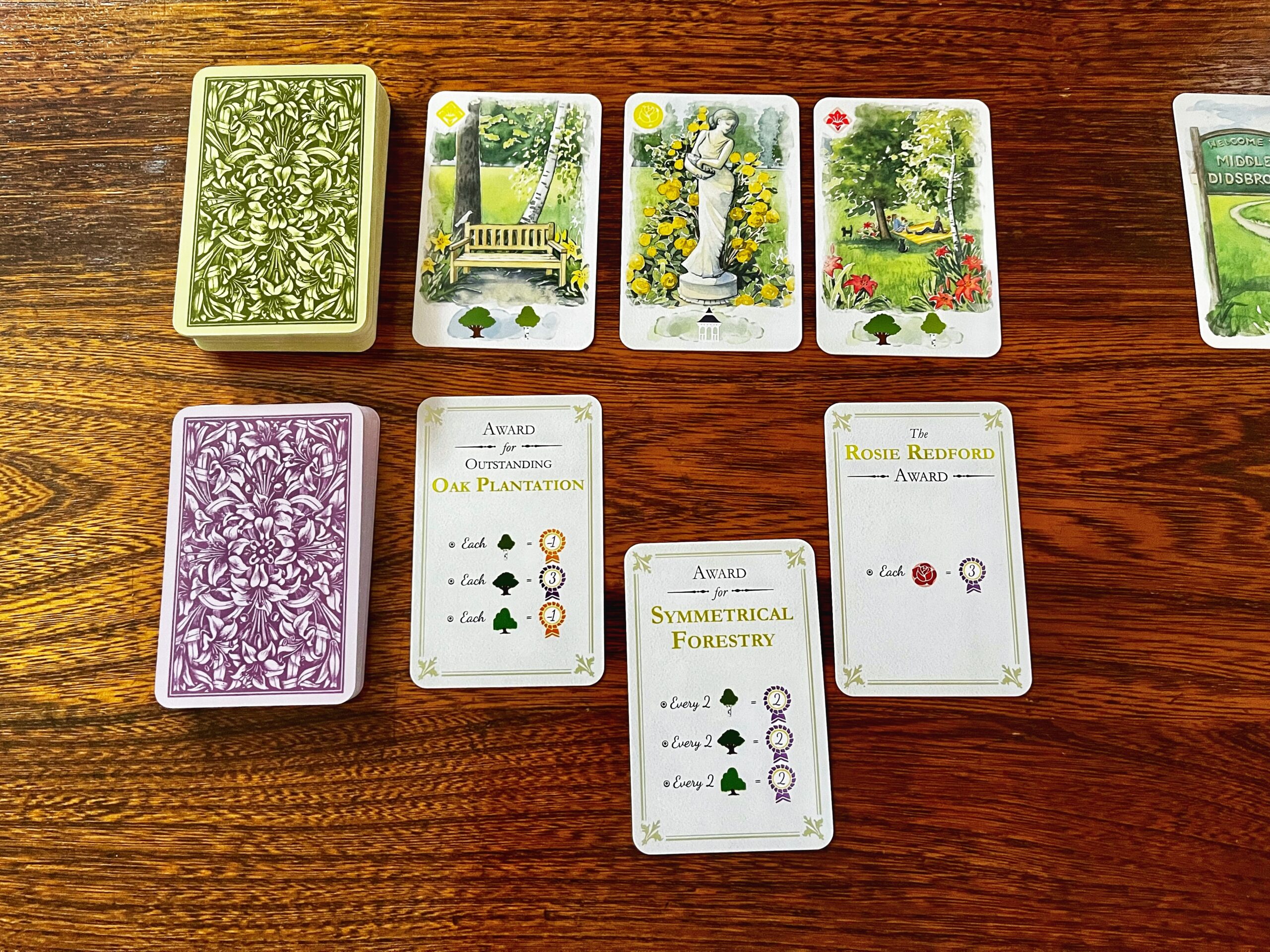
On their turn, this player will draw the “Award for Symmetrical Forest” card and play it to their village immediately.
Village Card Ability
Once per game, before taking an action on your turn, you may use your Village card’s special ability to:
- Discard the 3 faceup Green or Award cards and return them to the bottom of their respective draw pile and then replace the discarded cards with 3 new ones from the deck, or
- Take the “Draw and play a Green card” action and play it on top of any Green card already in your village, following the placement rules described in the next section.
When you use your Village card’s ability, turn it facedown to indicate that you can no longer use it during the game.
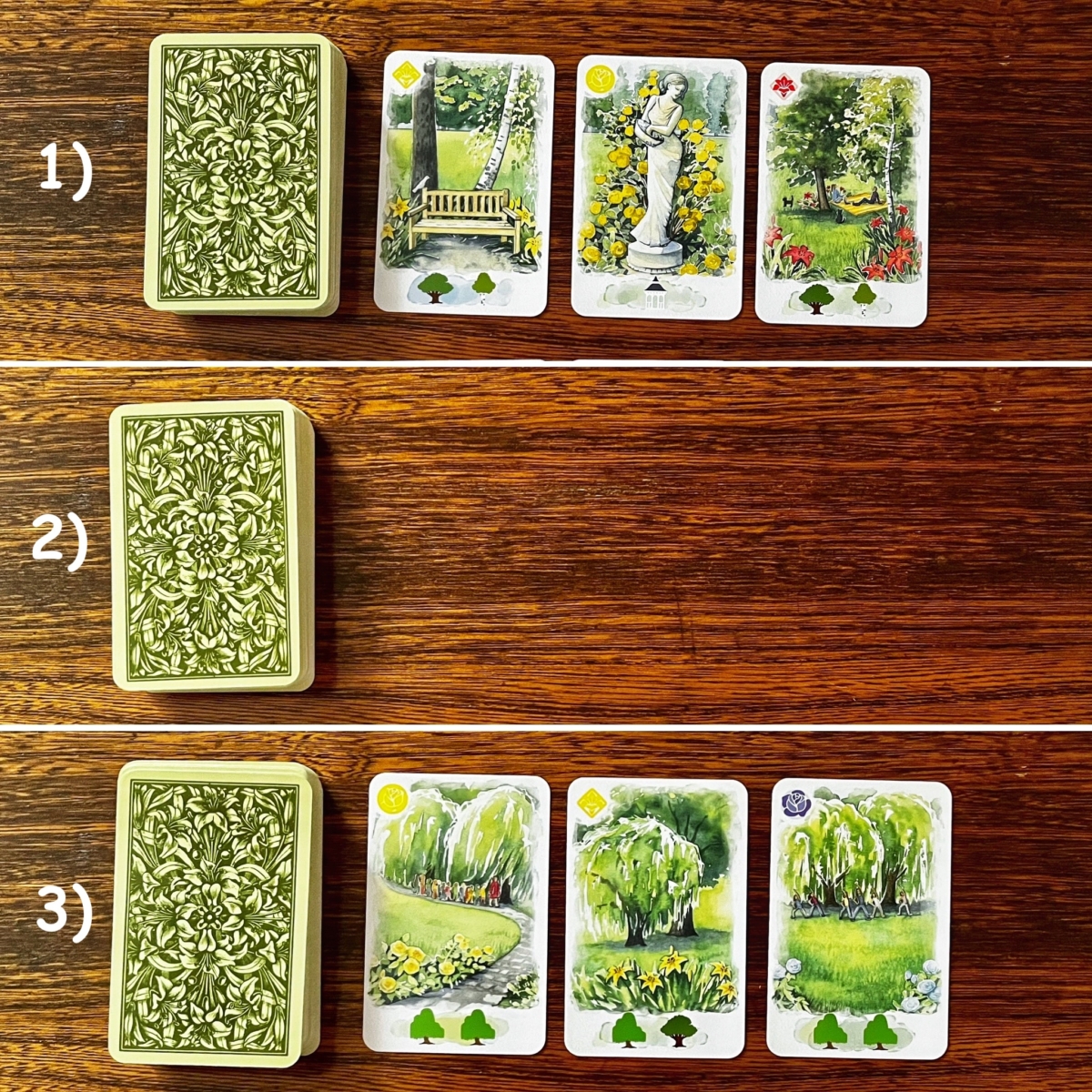
Before their action (1), this player uses their Village card to discard the 3 faceup Green cards, returning them to the bottom of the Green card draw pile (2). Then, they replace them with 3 new Green cards from the deck (3).
Playing Green Cards
Each player has space in their village for 9 Green cards. When you play a Green card, there are some placement rules to follow:
- You may never play Green cards to your village’s top row or leftmost column. (These spaces are reserved for Award cards and your Village card.)
- In general, you may not play a Green card on top of another Green card.
- The Green card must match each orthogonally adjacent card’s flower, color, or both. (If it doesn’t, you can’t play it there.)
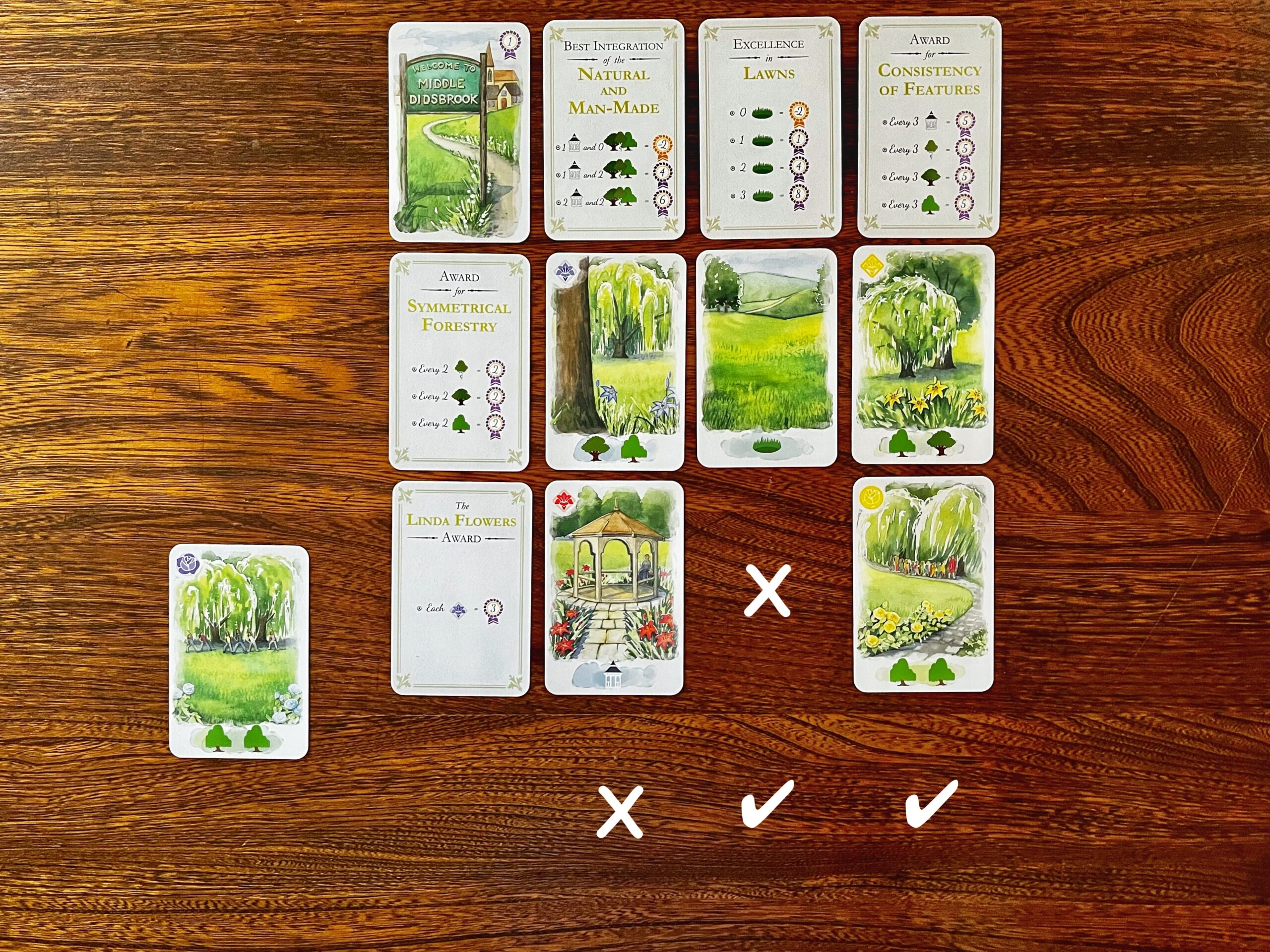
The blue rose Green card could be added to either place with a checkmark. It can’t be added to the spots with an X because it doesn’t match the color or the flower.
Features
As mentioned earlier, all Green cards have features at the bottom.
These features work in different ways and could score you points at the end of the game if you have an Award card that does so.
Trees
There are 3 kinds of trees: oak, birch, and willow. Trees only serve to score points at the end of the game.
Structures
When you play a Green card with a gazebo structure to your village, you must immediately draw and play an Award card.
Ponds
Each pond scores 2 points for a player at the end of the game, regardless of whether they have an Award card for them.
Lawns
Cards with lawns don’t have any flowers, so they may be placed anywhere in your village’s Green space. In a later turn, you may play a Green card on top of a lawn, following the usual placement rules.
Playing Award Cards
Your village has space for 6 visible Award cards, 3 in the top row and 3 in the leftmost column.
When you draw and play an Award card, you may play it to an empty space or on top of an already-played Award card (including the 3 with which you began the game).
However, in doing so, only the topmost (aka visible) cards score at the end of the game.
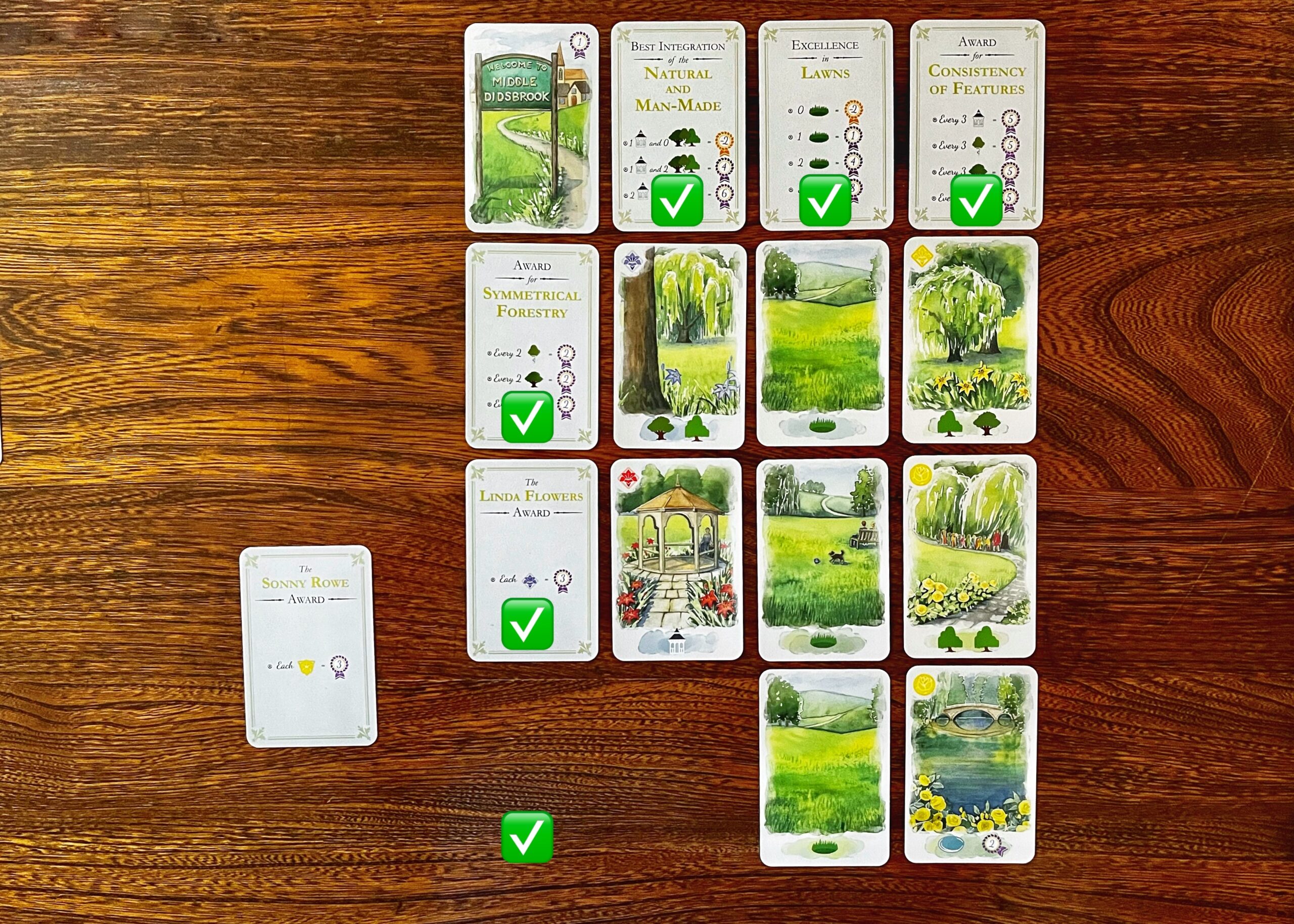
This person may play the “The Sonny Rose Award” card they drew on their turn in any of their village’s Award spaces (marked with a checkmark in the picture).
The placement of your Award cards is important because they only score the Green cards in their column or row.
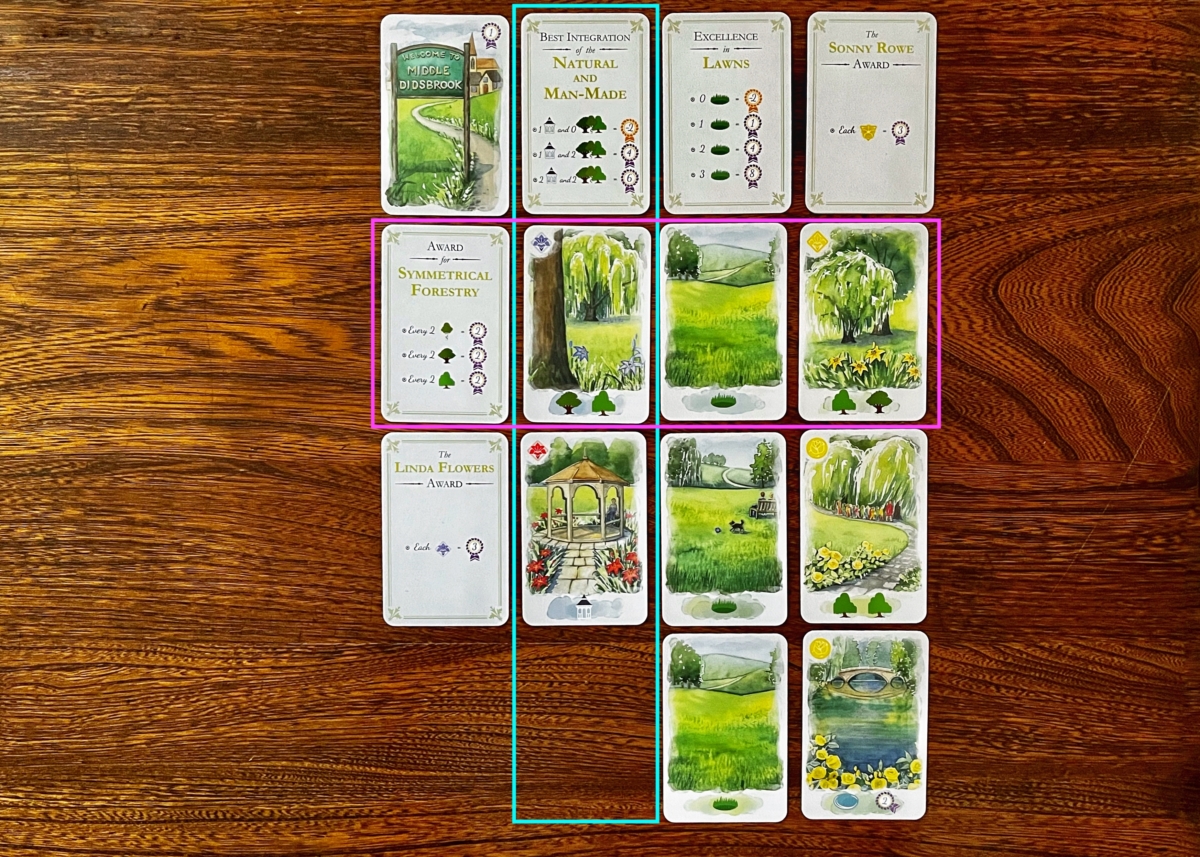
The “Best Integration of the Natural and Man-Made” Award card scores the 3 cards in its column (light blue), while the “Award for Symmetrical Forestry” card scores the 3 cards in its row (magenta). Both these Award cards will score the blue lily Green card.
End of Game
The game-end is triggered when any of the following occurs:
- A player has filled the 9 Green card spaces in their village.
- The Green card deck is empty.
- The Award card deck is empty.
When the end of the game is triggered, players continue taking turns clockwise until it reaches the start player. Then, players score their villages.
Scoring Your Village
You score:
- 2 points for every pond feature in your village.
- 1 point if you didn’t use your Village card ability.
- Points according to each Award card in your village.
The player with the most points wins!
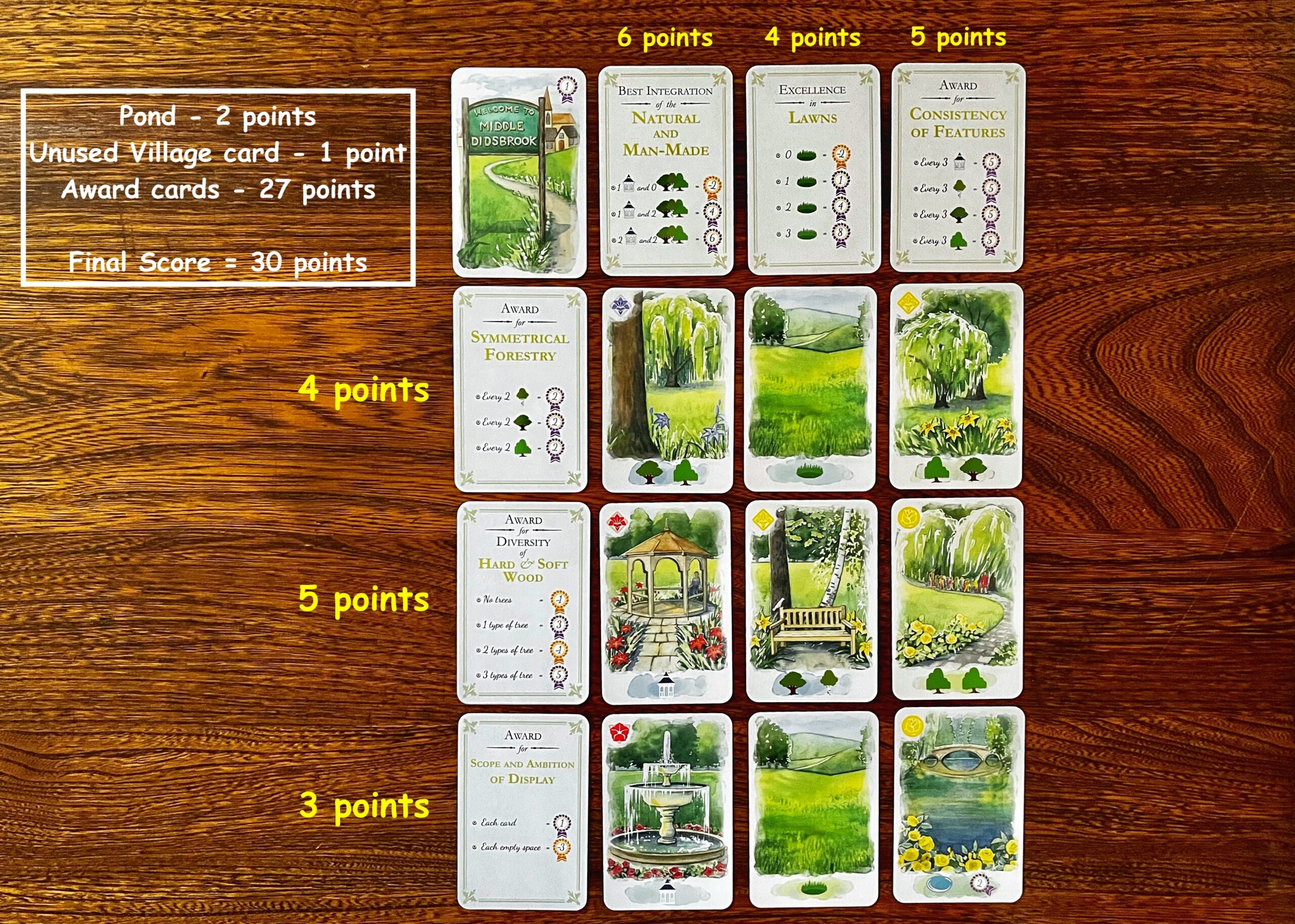
This player’s final score was, amazingly, 30 points.
Village Green Review
With its beautiful pastel tones and straightforward rules, Village Green fools you into thinking it’s a serene and pleasant little game; in reality, it is deceptively brain-burning.
This is because Village Green is such a tight game. You’re only playing 9 Green cards to your village to try to score your 6 Award cards optimally.
Strategically choosing when and which Award cards to place — and where — further intensifies the gameplay since you are forging your own path to victory.
All that may be rather easy if not for the Green card placement rules that create a complex spatial puzzle as you try not to back yourself in a corner — something that often happens with new players to the game.
Yellow Flowers Are Trouble
It may not be entirely apparent in this review’s photos (thanks to the closeness and image quality of the camera capturing them), but the yellow flowers — particularly the petunia and the lily — are quite difficult to tell apart.
This nuisance doesn’t keep me from wanting to play Village Green, but it does mean I have to spend more time closely examining the yellow cards than I would like.
Final Thoughts
Village Green is an interesting, tight, and tense card game that asks players to solve a complex spatial puzzle and lets them choose the unique scoring conditions they think will best lead them to victory.
You might also be interested in the following:

